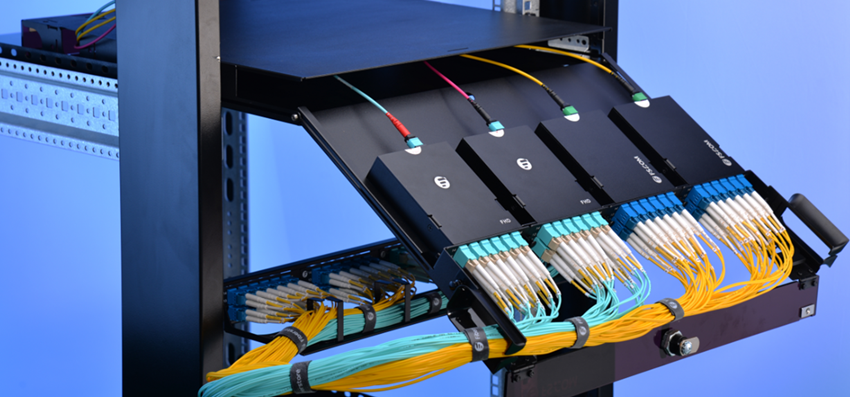Fiber optic cabling consists of strands of purified glass, or even plastic, rods that conduct specific wavelengths of light, analogous to the electrons carried along a Copper Ethernet Cable. However, light traveling through glass or plastic is not susceptible to the same problems that metal conductors are; The electromagnetic radiation that results from current traveling through a wire is not present in optical conductors, and optical conductors can be made much smaller than metal ones. Today, we’ll talk about the advantages and disadvantages of fiber optic cable.
Advantages and Disadvantages of Fiber Optic Cable
Everything has its own advantages and disadvantages. Learning the advantages and disadvantages of fiber optic cable, we may know how to select one when buying the cables.
There are four advantages of fiber optic cabling, these advantages explain why fiber is becoming the preferred network cabling medium for high bandwidth, long-distance applications:
All copper cable network media sharing a common problem: they are susceptible to electromagnetic interference (EMI), fiber optic cabling is immune to crosstalk because optical fiber does not conduct electricity and uses light signals in a glass fiber, rather than electrical signals along a metallic conductor to transmit data. So it cannot produce a magnetic field and thus is immune to EMI.
Because light is immune to interference, can be modulated at very high frequencies, and travels almost instantaneously to its destination, much higher data rates are possible with fiber optic cabling technologies than with traditional copper systems. Data rates far exceeding the gigabit per second (Gbps) range and higher are possible, and the latest IEEE standards body is working on 100Gbps fiber based applications over much longer distances than copper cabling. Multimode is preferred fiber optic type for 100-550 meters seen in LAN network, and since single mode fiber optic cables are capable of transmitting at these multi-gigabit data rates over very long distances, they are the preferred media for transcontinental and oceanic applications.
Typical copper media data transmission by the distance limits the maximum length of less than 100 meters. Because they do not suffer from the electromagnetic interference problems of traditional copper cabling and because they do not use electrical signals that can dramatically reduce the long distance, single-mode fiber optic cables can span 75 kilometers (about 46.6 miles) without using signal-boosting repeaters.
The Copper cable transmission media is susceptible to eavesdropping through taps. A tap (short for wiretap) is a device that punctures through the outer jacket of a copper cable and touches the inner conductor. The tap intercepts signals sent on a LAN and sends them to another (unwanted) location. Electromagnetic (EM) taps are similar devices, but rather than puncturing the cable,they use the cable’s magnetic fields, which are similar to the pattern of electrical signals. Because fiber optic cabling uses light instead of electrical signals, it is immune to most types of eavesdropping. Traditional taps won’t work because any intrusion on the cable will cause the light to be blocked and the connection simply won’t function. EM taps won’t work because no magnetic field is generated. Because of its immunity to traditional eavesdropping tactics, fiber optic cabling is used in networks that must remain secure, such as government and research networks.
With all of its advantages, many people use fiber optic cabling. However, fiber optic cabling does have a couple of disadvantages:
The higher cost of fiber optic cabling has little to do with the cable these days. Increases in available fiber optic cable manufacturing capacity have lowered cable prices to levels comparable to high end UTP on a per-foot basis, and the cables are no harder to pull. Ethernet hubs, switches, routers, NICs, and patch cords for UTP are very inexpensive. A high quality UTP-based 10/100/1000 auto-sensing Ethernet NIC for a PC can be purchased for less than $25. A fiber optic NIC for a PC costs at least four times as much. Similar price differences exist for hubs, routers, and switches. For an IT manager who has several hundred workstations to deploy and support, that translates to megabucks and keeps UTP a viable solution. The cost of network electronics keeps the total system cost of fiber-based networks higher than UTP, and ultimately, it is preventing a mass stampede to fiber-to-the-desk.
The other main disadvantage of fiber optic cabling is that it can be more difficult to install. Ethernet cable ends simply need a mechanical connection, and those connections don’t have to be perfect. Fiber optic cable can be much trickier to make connections for mainly because of the nature of the glass or plastic core of the fiber cable. When you cut or cleave (in fiber optic terms) the fiber, the unpolished end consists of an irregular finish of glass that diffuses the light signal and prevents it form guiding into the receiver correctly. The end of the fiber must be polished and a special polishing tools to make it perfectly flat so that the light will shine through correctly.
Conclusion
From the above, we have learnt the advantages and disadvantages of fiber optic cable. Knowing the advantages and disadvantages of fiber optic cable can help us to choose a suitable fiber cable. For more details about fiber cables, please visit FS.COM.
Related Articles:
Multimode Fiber Types: OM1 vs OM2 vs OM3 vs OM4 vs OM5
Single Mode vs Multimode Fiber: What’s the Difference?









